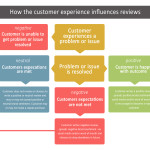How To Improve Your Online Reviews | Social Media Today

When it comes to bad online reviews and negative brand sentiment, i’ve got a fair bit of experience in the area. I spent 18 months working for a prominent online retailer, who over the years, had managed to amass a startling number of dissatisfied customers. This dissatisfaction manifested itself in a veritable avalanche of negative reviews and sentiment. Before any active online marketing could commence, the first priority was to stem the tide of negativity and that meant understanding where it had all come from.
It turns out that a profit focused approach had been used for years, leaving in it’s wake a plethora of customers unhappy with the service they had received. With old processes still in place, it was impossible to instigate change, so this acted as the starting point. Gradually, the internal culture was changed, and new processes were put in place that addressed some of the common issues our customers were facing.
Turning Negative Sentiment Around
Once the internal changes had been introduced, the number of complaints and negative reviews started to drop. Instead of the usual daily dose of disparaging posts on social media, we started seeing something we’d never before seen. Positive feedback and interactions on social media from happy customers. Over a number of months, the general tide of negativity was stemmed, allowing us to start repairing and actively managing our online reputation.
Many businesses thankfully, don’t have such an uphill battle when it comes to reputation management, but this proves that without basic customer service processes in place, no matter what you do online, you’ll face the constant task of damage limitation and a steady flow of negative feedback and reviews. Get the customer service basics right and only then can you start turning negative brand sentiment around.
Dealing With Bad Reviews
There is one thing that is certain when it comes to negative reviews, and that is, they will not go away. Without intervention, negative sentiment can proliferate, and by not actively responding to negative reviews, it reinforces the belief that you just don’t care about your customers.
A negative review can prime a customer for a disappointing experience from the outset
Customers face so much choice these days, that reviews now play an important role in the decision making process. A negative review on any given platform, brings your businesses average rating down, and it plants a seed of doubt in a potential customers mind. This may prime them for a disappointing experience from the outset, or it can influence them to simply shop with a competitor instead.
Bad reviews do not go away and they have a powerful influence on the purchasing decision
Given consumers have so much power when it comes to reviews, doing all you can to make sure your customers have a good shopping experience is a no-brainer. However, no matter how hard you try, there are always going to be times when your service fails to live up to expectations and because of this, businesses can often feel helpless to stem a steady flow of negativity, causing them to ignore or simply shrug off bad reviews.
Why Do Customers Write Bad Reviews?
The reasons for a customer writing a bad review in the first place are a lot more complex than you might at first imagine. For any business there are going to be times when your service falls short; you might be understaffed for a period of time, you might have been let down by suppliers or you may be experiencing temporary technical difficulties.
The first thing to understand is that no matter how good your business is, you will still receive bad reviews from time to time from dissatisfied customers, learning how to deal with them is key.
Customers who are unable to get their issues dealt with, or who have their problems resolved in a way that does not satisfy them are likely to be left feeling frustrated or angry. A missed or a failed delivery is inconvenient and can cause anger, whilst being unable to get through on the telephone to your customer services team to report the receipt of a damaged product can cause a customer to retaliate in frustration by posting a negative review.
Resolving an issue doesn’t mean your customer will be happy with process or the outcome
Even when you have resolved an issue, this doesn’t mean the customer will be happy. If at the end of the process the customer feels like they have been unduly inconvenienced, even if you have put the situation right from your point of view, they might still be motivated to post a negative review. In such cases, simply rearranging a failed delivery or missed appointment might not be enough.
Your Business Must Be Customer-centric
Good old fashioned customer service should never be underestimated, and making sure you have processes in place to help people resolve issues is vital. Take a fresh look at your ordering process from the perspective of a new customer. Use feedback from your sales and/or customer service team to figure out where problems are most likely to occur and introduce change to eliminate those pain points entirely, or failing that, make it easy for customers experiencing problems, to get them sorted out.
A dedicated customer service page is a must, so make sure you provide key information that will allow customers to get the help they need as quickly and easily as possible.
Have A Clear, Simple Problem Resolution Process
By having a clear and simple problem resolution process, you will effectively minimise the helplessness customers often feel when something goes wrong. Providing an easy and effective way of reporting a problem and in responding quickly in order to resolve that problem, you can turn a negative situation around.
Trust Pilot recently claimed that businesses can see an increase in sales of up to 58% thanks to good reviews
Your problem resolution process must take into account the unique needs of your customers – whilst your legacy forum based support ticketing system might be what you have in place, this doesn’t make it the most convenient system for your customers to use. Bear in mind the shift in recent years in how customers prefer to interact with businesses. For many, picking up the telephone seems archaic and will instantly feel like a hassle so take into account the demographics of your customer base and always make sure you are monitoring social media channels and people will often turn to Twitter before they even look at your website to find your contact details.
It is relatively easy to ensure the number of positive reviews outnumber the negative ones
When dealing with customers, be polite, understanding and show some empathy towards them. It really isn’t difficult to diffuse an angry customer and neutralise their negativity. Taking this seriously is critically important as every single customer you deal with has the potential to make their feelings publicly known.
You don’t even have to resolve a problem if you deal with the complaining customer with the right attitude. Simply being helpful and understanding can speak volumes and shows a customer that you care, even if a problem is beyond your control and can’t be fixed.
10 Tips To Help You Get Better Reviews
- Use empathy to relate to your customers. Their delivery might have been delayed by only 24 hours, but if their purchase was time critical, they are likely to be far more upset than someone who see’s the delay as a small inconvenience.
- Remember that customers are most likely to complain or leave negative reviews when they feel frustrated and powerless. Keep them informed and provide solutions in order to help them overcome this feeling of frustration.
- Whilst processes are generally good, a dose of common sense will help you deal with customer service issues on a case by case basis. Giving an unhappy customer a discount on their next order is likely to be seen as rubbing salt into the wound, when offering to refund their shipping for their current order might appease them more effectively.
- Remember that some customers will never be happy no matter what you do, so do be prepared to respond to negative reviews from difficult, angry customers in a professional and pragmatic way.
- A gesture of goodwill can go a long way in restoring a customers faith in a brand and can effectively neutralise negative sentiment.
- Make sure you are actively monitoring social media so you can spot and deal with any issues as they arise. Jump in on negative brand mentions and ask how you can help or provide the customer with details of how to take things further.
- Ignoring negative reviews or customer complaints on social media will make you look unprofessional and like you don’t care about your customers – make sure you respond to negative Tweets, Facebook posts and that you sign up on review sites so you can respond directly to negative reviews.
- Make sure that your website and processes paint a realistic picture of the service that you will provide. For example, it is common for delivery to take only a few days, so if you don’t carry stock or have longer delivery lead times, make sure you clearly state this so customers will not have unrealistic expectations in place.
- Make sure you have good basic levels of customer service and a clear resolution process in place. Without this, customers are likely to continue to be disappointed by their experience and frustrated when they are unable to get issues dealt with.
- After a purchase, automatically contact your customer and request they take a moment to leave a review. Make sure you provide them with an alternative option if they are having problems, or if their experience wasn’t as expected. By providing them with an alternative option, you’ll minimise the chances of a customer writing an angry review instead of contacting you to give you a chance to sort it out for them. The wording of your email can have a big impact here so choose your words wisely, but make sure you don’t solicit or incentevise good reviews as this falls foul of the guidelines that many of the big review sites have.
For more insight into how to deal with your customers on social media, see the article Why I stopped following my favourite brand on social media.
The post Improve Online Reviews With Good Old Fashioned Customer Service appeared first on Marketing & Social Media Blog | Marketing insights, tips and advice.
Link:
How To Improve Your Online Reviews | Social Media Today


